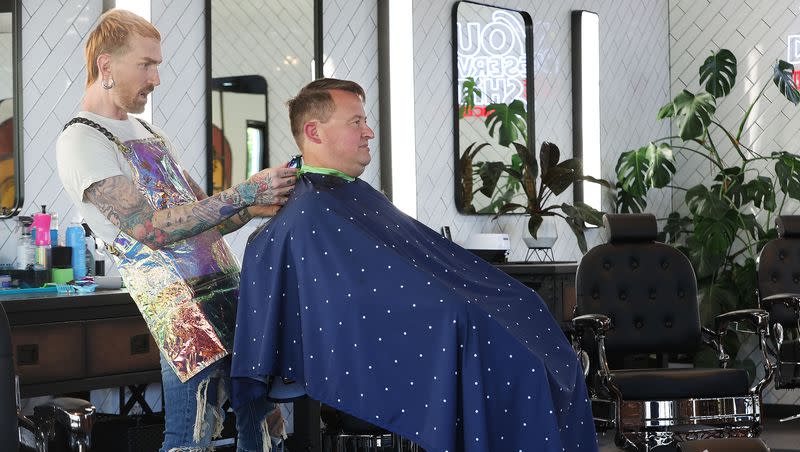Watch out, smarty-pants: College-educated and higher-paid workers most at risk for replacement by AI, according to new report

Among a host of worries about emerging artificial intelligence tools, including its potential to breach personal privacy, flaunt copyright protections, perpetuate discrimination and perhaps even foment an extinction event for its human progenitors, the most near-horizon concern may be about AI inching closer to replacing flesh-and-bone workers on a massive scale.
An analysis published in March by financial giant Goldman Sachs underscores how fast-advancing generative artificial intelligence engines are poised to provide a boon for the business world by automating tasks currently being performed by people in a swap-out cycle that will “drive labor cost savings and raise productivity.” It’s a replacement arc that comes with a serious human toll that could, according to the Goldman breakdown, fuel hundreds of millions of job losses around the world.
“If generative AI delivers on its promised capabilities, the labor market could face significant disruption,” Goldman Sachs researchers wrote. “Using data on occupational tasks in both the U.S. and Europe, we find that roughly two-thirds of current jobs are exposed to some degree of AI automation, and that generative AI could substitute up to one-fourth of current work.
“Extrapolating our estimates globally suggests that generative AI could expose the equivalent of 300 million full-time jobs to automation.”
So, who should be most concerned about losing their job to an AI-driven digital system?
A new study from Pew Research released Wednesday finds a fifth of all U.S. workers have high exposure to possible AI replacement and among that group, women, Asian, college-educated and higher-paid workers are most exposed.
Pew researchers note that, historically, changes in technology have often automated physical tasks, such as those performed on factory floors. But new artificial intelligence innovations perform more like human brain power and, as its reach grows, it is raising questions about its impact on professional and other office jobs.
Related
Based on an assessment of 2022 government employment and wage data, researchers found that 19% of American workers are in jobs that are the most exposed to AI, in which the most important activities may be either replaced or assisted by AI. About a quarter of workers, 23%, have jobs that are the least exposed to AI, in which the most important activities are farther from the reach of AI. Other workers, nearly 6 in 10 in all, are likely to have varying levels of exposure to AI, according to Pew’s findings.
Authors of the report note they used an exposure ranking that refers to the likelihood that the activities workers perform on their jobs may be replaced or aided by artificial intelligence.
Pew analysts find that jobs with a high level of exposure to AI replacement tend to be those that pay higher wages and require a college education and analytical skills. Other groups of workers with higher levels of exposure to AI, according to the Pew report, include:
Those with more education: Workers with a bachelor’s degree or more (27%) are more than twice as likely as those with a high school diploma only (12%) to see the most exposure.
Women: A greater share of women (21%) than men (17%) are likely to see the most exposure to AI. This is because of differences in the types of jobs held by men and women.
Asian and white: Asian (24%) and white (20%) workers are more exposed than Black (15%) and Hispanic (13%) workers.
Higher-wage workers: In 2022, workers in the most exposed jobs earned $33 per hour, on average, compared with $20 in jobs with the least amount of exposure.
Researchers say the job activities that AI excels at replacing include “getting information” and “analyzing data or information” and “working with computers.” Jobs with task activities with more physical components tended to fall into lower exposure risks.
Some examples of job types and their relative exposures to AI replacement include:
High exposure
Budget analysts.
Data entry keyers.
Tax preparers.
Technical writers.
Web developers.
Medium exposure
Chief executives.
Veterinarians.
Interior designers.
Fundraisers.
Sales managers.
Low exposure
Barbers.
Child care workers.
Dishwashers.
Firefighters.
Pipelayers.
Barber shop owner Isaac Atencio said he wasn’t at all surprised to hear that his profession fell into the low exposure category in the Pew report but noted AI tools were definitely playing a role in how he and his partner operate their two Salt Lake Barber Co. shops in Salt Lake City.
“Obviously, the things we get a little more hands-on with are going to be the things that stick around past when AI takes over,” Atencio said. “But, that’s not to say it isn’t a tool that we can benefit from and already do.
“We use an AI-driven automated receptionist. When you call into the barbershop you have the option to get a text response from an AI chatbot … which can provide answers to the most common questions without us having to field the conversation. It saves us the need to hire a receptionist. If the chatbot can’t answer the question the call gets kicked over to myself or my business partner.”

Atencio also noted that, in addition to the training, experience and physical fitness required to perform barber services being relatively safe from replacement by some manner of AI-powered barber-bot, what his shops offer goes beyond the fresh haircut, beard trim or straight-razor shave.
“What we’re trying to achieve is an environment that feels like a spa, where our clients can enjoy a moment of just being pampered,” Atencio said. “The reality is you can provide a haircut that is just OK, but we’re aiming higher than that, building personal relationships and providing an experience that exceeds the quality of the cut.”
Generative AI platforms like ChatGPT, Bard, DALL-E and others can generate text, audio files, images and video that are becoming increasingly difficult to discern from content produced by humans. Some of the tools are also capable of performing wide data science functions, produce detailed reports and analysis and even write computer code for new programs and applications.
According to results from a Deseret News/Hinckley Institute of Politics poll conducted last month, Utahns don’t appear to be particularly worried about being replaced by worker ‘bots or super smart AI-driven programs.
The statewide survey found only 28% of respondents who are currently working are concerned about AI leading to job losses in their industries and of that group, only 9% said they were very concerned. A solid majority of poll participants, 69%, said they weren’t worried about artificial intelligence-driven tools replacing them at work, with 52% weighing in as not at all concerned.
While Goldman Sachs analysts assembled an estimate of potential job losses that could be at hand due to replacement by AI programs, Pew researchers noted a high level of uncertainty about the broader impacts of the digital innovations.
Pew report authors posed a scenario about AI’s potential impacts, using the job of customer service agent as an example case, noting evidence shows that AI could either replace them with more powerful chatbots or it could enhance their productivity. Researchers noted AI may also create new types of jobs for more skilled workers — much as the internet age generated new classes of jobs, such as web developers.

